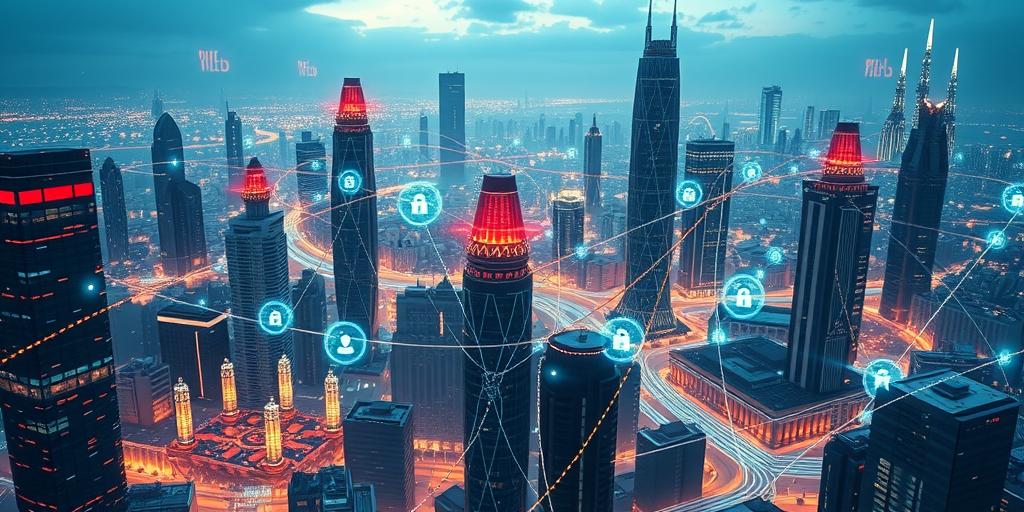The rapid advancement of technology has ushered in an era of smart cities, where interconnected systems and data-driven solutions are transforming urban life. This evolution, however, presents a new set of challenges, particularly in the realm of cybersecurity. As smart cities become increasingly reliant on sophisticated technology, ensuring the security of their infrastructure and data is paramount.
The Rise of Smart Cities and the Growing Need for Cybersecurity
Smart cities are a vision of urban environments that leverage technology to enhance efficiency, sustainability, and livability. From traffic management systems to smart grids and intelligent street lighting, these cities are built on a foundation of interconnected devices, sensors, and networks.
The Evolution of Smart Cities
The concept of smart cities has evolved significantly over the years, fueled by advancements in areas like cloud computing, mobile technologies, and the Internet of Things (IoT). Early initiatives focused on individual applications, but the focus has shifted towards creating integrated systems that work together to improve city operations and citizen experiences.
The Interconnected Nature of Smart City Infrastructure
One of the key characteristics of smart cities is their highly interconnected nature. Smart city infrastructure relies on a complex web of networks, devices, and software that communicate and share data in real-time. This interconnectedness brings about numerous benefits but also creates vulnerabilities that cybercriminals can exploit.
Cybersecurity as a Critical Component of Smart City Development
Cybersecurity is no longer an afterthought but an essential pillar of smart city development. As cities embrace digital transformation, safeguarding their critical infrastructure and data from cyberattacks becomes a fundamental necessity. A robust cybersecurity framework is vital for protecting citizens, ensuring operational continuity, and maintaining public trust.
Key Cybersecurity Challenges in Smart Cities
The interconnected nature of smart cities and the reliance on sensitive data create a unique set of cybersecurity challenges. These challenges require careful consideration and proactive solutions to ensure the safety and resilience of smart city environments.
Data Security and Privacy
Smart cities collect and process vast amounts of data, including personal information, financial transactions, and critical infrastructure control data.
Sensitive Data Collection and Storage
The collection and storage of this sensitive data raises concerns about privacy and data security. Cybercriminals may target these databases to steal personal information, compromise financial systems, or disrupt city operations.
Data Breaches and Their Impact
Data breaches can have devastating consequences for smart cities. Stolen data can be used for identity theft, financial fraud, or even to compromise critical infrastructure. In addition, breaches can damage public trust in smart city initiatives and lead to reputational damage.
Infrastructure Resilience
The interconnectedness of smart city infrastructure means that a cyberattack on one system can potentially impact other systems. This interdependence makes it crucial to build resilience into smart city infrastructure to withstand cyber threats.
Critical Infrastructure Interdependence
Smart cities rely on interconnected systems for essential services like transportation, energy, and water management. A cyberattack on one of these systems could disrupt critical infrastructure and have significant consequences for residents.
Cyberattacks on Smart City Systems
Cyberattacks on smart city systems can range from denial-of-service attacks that disrupt traffic lights or power grids to data breaches that compromise sensitive information. These attacks can have significant economic, social, and environmental impacts.
Emerging Technologies and Cybersecurity Risks
The rapid adoption of emerging technologies like artificial intelligence (AI), machine learning, and the Internet of Things (IoT) introduces new cybersecurity risks.
Artificial Intelligence and Machine Learning
AI and machine learning are transforming smart city operations, but they also create new vulnerabilities. Malicious actors can manipulate AI algorithms or exploit vulnerabilities in machine learning systems to disrupt or compromise smart city services.
Internet of Things (IoT) Devices
IoT devices are becoming increasingly prevalent in smart cities, but they often lack robust security measures. This makes them vulnerable to cyberattacks that can be used to steal data, disrupt services, or even control physical devices.
Strategies for Enhancing Cybersecurity in Smart Cities
Addressing the cybersecurity challenges facing smart cities requires a multi-faceted approach that involves proactive security measures, collaborative initiatives, and a commitment to building a cybersecurity culture.
Proactive Security Measures
Investing in robust security measures is essential for protecting smart city infrastructure and data.
Strong Authentication and Access Control
Implementing strong authentication protocols and access control mechanisms can help prevent unauthorized access to sensitive systems and data. Multi-factor authentication, role-based access control, and regular password changes are vital components of a strong security posture.
Regular Security Audits and Vulnerability Assessments
Regular security audits and vulnerability assessments help identify and address weaknesses in smart city systems before they can be exploited by cybercriminals. These assessments should cover all aspects of the infrastructure, including networks, devices, software, and data storage.
Collaborative Security Approaches
Sharing information and collaborating with other stakeholders are crucial for enhancing cybersecurity in smart cities.
Information Sharing and Threat Intelligence
Sharing threat intelligence and best practices among city governments, cybersecurity companies, and other stakeholders can improve situational awareness and enable quicker responses to emerging threats.
Public-Private Partnerships
Public-private partnerships can foster collaboration and innovation in cybersecurity. Working with private sector experts can provide cities with access to advanced technologies, expertise, and resources that can help strengthen their security posture.
Building a Cybersecurity Culture
A strong cybersecurity culture is essential for protecting smart cities. This requires a commitment to raising awareness, investing in expertise, and promoting a culture of security throughout the city.
Awareness Training for City Officials and Residents
Providing cybersecurity awareness training for city officials, employees, and residents can help reduce the risk of human error and social engineering attacks. This training should cover topics like phishing scams, malware, and best practices for securing personal devices.
Investing in Cybersecurity Expertise
Investing in cybersecurity expertise within city governments and public agencies is essential for developing and implementing effective security strategies. This includes hiring qualified cybersecurity professionals and providing them with ongoing training and development opportunities.
The Future of Cybersecurity in Smart Cities
The cybersecurity landscape is constantly evolving, with new threats and technologies emerging all the time. To stay ahead of these challenges, smart cities need to embrace a future-proof approach that prioritizes continuous adaptation and innovation.
Emerging Threats and Challenges
As smart cities adopt more advanced technologies, they will face new and evolving cybersecurity threats. These may include:
- AI-powered attacks: Malicious actors may use AI to create more sophisticated and targeted attacks.
- Quantum computing: The development of quantum computers could pose a significant threat to current encryption methods.
- Edge computing: The increasing use of edge computing creates new vulnerabilities for data security and privacy.
Technological Advancements in Cybersecurity
Fortunately, technological advancements in cybersecurity are also evolving rapidly. These advancements can be leveraged to enhance the security of smart city infrastructure and data.
- Next-generation firewalls: These firewalls offer advanced threat detection and prevention capabilities.
- Behavioral analytics: This technology can identify and block suspicious activity based on user behavior.
- Security information and event management (SIEM): SIEM systems can provide real-time visibility into security events across the entire smart city infrastructure.
The Importance of Continuous Adaptation and Innovation
To stay ahead of emerging threats and take advantage of new technologies, smart cities need to embrace a culture of continuous adaptation and innovation in cybersecurity.
- Regularly updating security policies and procedures: City governments need to keep their security policies and procedures up-to-date to reflect evolving threats and technologies.
- Investing in research and development: Cities should invest in research and development to explore new cybersecurity solutions and technologies.
- Building partnerships with cybersecurity experts: Establishing strong partnerships with cybersecurity experts in academia, industry, and government can provide access to cutting-edge knowledge and solutions.
Conclusion: Securing the Future of Smart Cities
The future of smart cities is inextricably linked to the success of their cybersecurity efforts. Building a secure and sustainable smart city ecosystem requires a holistic approach that prioritizes data security, infrastructure resilience, and a strong cybersecurity culture.
The Importance of a Holistic Cybersecurity Approach
A holistic approach to cybersecurity encompasses all aspects of the smart city environment, from the physical infrastructure to the data and applications that power city services. This approach requires a coordinated effort among city governments, private sector partners, and citizens.
The Role of Collaboration and Innovation
Collaboration and innovation are essential for building a secure future for smart cities. By working together, city governments, cybersecurity experts, and technology providers can develop and implement innovative solutions that address the evolving challenges of cybersecurity.
Building a Secure and Sustainable Smart City Ecosystem
By embracing a comprehensive cybersecurity strategy, investing in advanced technologies, and fostering a culture of security awareness, smart cities can create a secure and sustainable ecosystem that benefits both residents and businesses. This will pave the way for a future where innovation and security go hand in hand, ensuring that smart cities can realize their full potential while protecting their citizens and critical infrastructure.




